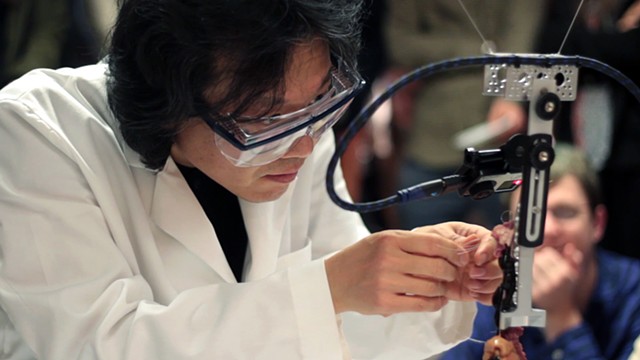Biography
Doo Sung Yoo is a Korean new media artist and an Assistant Professor of Teaching in the Art and Technology area of the Department of Art at The Ohio State University. He synthesizes scientific research within his artwork and interweaves interdisciplinary media between professional fields. He is focused on creating hybrid sculptural and interactive entities, in which a human performer is conjoined with disembodied animal organs integrated with electronic devices within mechanical bodies. He currently explores virtual network entities as expanding hybrids that enhance interspecies relationships between human and non-human living organisms within experimental immersive art forms.
His artworks have been shown in many exhibitions and art festivals, such as Prospectives.09 at Reno, Nevada, Ingenuity Fest at Cleveland, Ohio, and Art in Odd Places: Care at New York City, New York. His experimental art hybrids have been focal points of academic conferences and symposiums, including International Symposium on Electronic Art at Albuquerque, New Mexico, Speculative Futures at Arts Santa Mònica (Barcelona, Spain), Bodies on Stage: Acting Confronted by Technology (Paris, France), the keynote speech of Borderlines IV: Resisting, Persisting, Performing (Leicester, England), and Transmedia Arts Seminar at Mahindra Humanities Center of Harvard University. His organ-machine hybrids were nationally and internationally reviewed and published in art magazines, books and journals, such as ‘Performance Research: A Journal of the Performing Arts’ (England), ‘Bio-Aesthetics: The Production of Life in Contemporary Art’ (Switzerland), ‘Tierstudien’ (German), ‘Antennae: The Journal of Nature in Visual Culture’ (England), ‘Evolution Haute Couture: Art and Science in the Post-Biological Age’ (Russia), ‘Wi: Journal of Mobile Culture’ (Canada), the American art journal, ‘Media-N’, and ‘Posthumanism in Art and Science: A Reader’ by Columbia University Press. He has been critically discussed in and featured by leading art publications in his native Korea, such as ‘Art & Criticism’, ‘ArtWIDE’, and ‘Misulsegye’.
Artist Statement
I create environments in which living entities and biological materials, including the human body, are combined with technological systems. In these environments, technology mediates the confluence between two binary oppositions, such as human and non-human, human and machine, living and dead, and normal and abnormal. My artwork is based on those intersections between natural and unnatural (artificial) worlds. I synthesize organic and mechanical components into spectacles both ‘repulsive and beautiful’.
My project, Organ-machine Hybrids, has probed the ‘technologically-augmented body’, in which biological and mechanical systems are integrated and where humans and machines must cooperate in order to exist as hybrids. This project also implements collaborations between the hybrids and human performers and/or living animals within installations, visual performances, and theatrical forms. These explorations are based on my questions about how the combinations of biological materials, living entities, and machines could be contextualized within art, how the agenda of extending the human and non-human body could be explored within the aesthetic realm, and how new media artists contribute critical views and thoughts to correlations of human, nature, and machine in their co-evolution.
I use the language of video to embrace a larger audience. I hope that the cinematic visualizations will spark curiosity in those who are willing to explore hybridization, cyborg, and lifelikeness in the Organ-machine Hybrids. My use of multidisciplinary performance, installation, and robotic sculpture creates a mix of technical exposition and immersive narrative allowing the viewer to approach the themes from multiple perspectives. I strive to keep a balance between the ‘conceptual’ and the ‘technical’. My videos are a combination of scientific plausibility and artistic conceptualization that helps maintain the suspension of disbelief when encountering these unrealistic human-machine hybrids through performance and installation.
Doo-Sung Yoo
